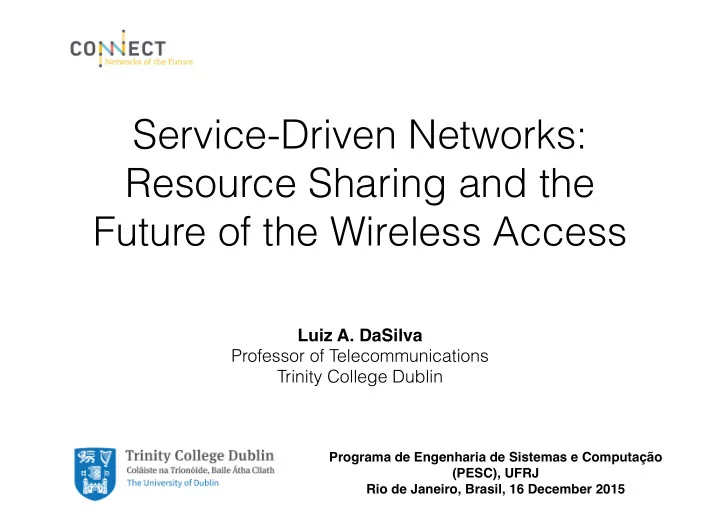

Service-Driven Networks: Resource Sharing and the Future of the Wireless Access Luiz A. DaSilva � Professor of Telecommunications Trinity College Dublin Programa de Engenharia de Sistemas e Computação (PESC), UFRJ � Rio de Janeiro, Brasil, 16 December 2015
To ¡evolve ¡future ¡wireless ¡networks: New ¡spectrum ¡licensing ¡regimes ¡ More ¡spectrum ¡(e.g., ¡mm-‑wave, ¡ Cell ¡densifica@on ¡ licensed ¡+ ¡unlicensed) ¡ Sharing ¡of ¡infrastructure, ¡ More ¡antennas ¡(massive ¡MIMO) ¡ backhaul, ¡processing, ¡storage ¡ More ¡technologies Virtualised ¡wireless ¡networks
Vision Wireless networks of the future will be characterised by heterogeneity of spectrum usage regimes of ownership models of radio access technologies where resources are shared and orchestrated to create bespoke, virtual networks designed for specific services Inter-operator RAN and spectrum sharing is a key step towards that future cost efficiencies, tempered by competitive advantage considerations regulatory constraints
Virtualisation = the illusion of exclusive access to physical resources that are, in fact, shared A virtual wireless access network feels to the user like a traditional network operated by a single entity but is in fact orchestrated out of a diverse pool of resources with different ownership models A set of physical resources can host several virtual networks
[Doyle, Forde, Kibiłda, DaSilva, Proc. of IEEE 2014] Future wireless networks will rely on sharing and virtualisation � … and this requires the ability to slice and trade resources
Increased efficiency and lower costs through: 1. Incentives for the deployment of localised (small cell, primarily) infrastructure by medium-sized and small operators. 2. The ability to provide service over infra ‐ structure that employs heterogeneous technologies, and has different properties and ownership. 3. Improved service in currently under ‐ served areas. 4. The ability to offer virtual wireless networks with different associated quality of experience, at different price points.
New questions… 1. How to select physical resources to meet the needs of a virtual operator? 2. How to dynamically manage these virtual networks? 3. How to ensure security, and privacy? 4. What economic and public policy models will support this new model? (…)
Approaches stochastic geometry optimisation game theory real data
Optimization To assess gains from resource sharing under diverse sets of technical, market, and regulatory constraints
Stochastic Geometry To find appropriate stochastic models for combined network deployments by multiple operators, and to assess the resulting performance of shared networks
Game Theory To assess the effect of possibly conflicting objectives among independent decision makers and to design mechanisms that lead to socially desirable outcomes
Our starting point… Sharing decisions among network operators Illustrative problem: can infrastructure sharing be traded for spectrum sharing?
No sharing Infrastructure only Spectrum only Infrastructure + Spectrum
[Kibiłda, Di Francesco, Malandrino, DaSilva, IEEE DySPAN 2015]
Some results…
Independently deployed infrastructure Clustered infrastructure Co-located infrastructure Validation of closed-form expressions for coverage probability (hPPP)
Effects on data rate
• Infrastructure and spectrum cannot be simply substituted for each other, as they bring a tradeoff in coverage and capacity • The combination of infrastructure and spectrum sharing does not bring linearly scaling gains • The spatial distribution of the networks has a significant impact on the gains brought about by sharing • The respective densities of the networks of the two operators influences how each perceives the sharing gains • Results of spectrum sharing are overly pessimistic as they consider no spectrum management or frequency planning
PPP Hexagonal LGCP Dublin (real data) Clustered point processes to model multi-operator deployments Premise: multi-operator RAN deployments exhibit significantly more clustering than single-operator Investigate goodness of fit of log-Gaussian Cox process (LGCP), Matern cluster process (MCP) and Thomas process (TP) Deployment data from Ireland, Poland, and the UK
Empty space function (F function), fitted with a second-order statistic (pair-correlation function) Fit shown for UMTS deployments in Dublin (Three, Vodafone, Meteor) Envelope of 99 realisations of the fitted point process model shown in grey Similar results for other urban areas investigated
[Kibilda, Galkin, DaSilva, TMC 2016] Coverage probability: again LGCP provides the closest match to real data Combined multi-operator deployments seem to cluster at shorter distances (high demand areas) and repulse at longer LGCP and cluster point processes provide a reasonable fit to such multi- operator deployments Results are robust to various countries tested for in Europe
• Sharing (of infrastructure, spectrum, processing, …) will be increasingly important as wireless networks evolve • Optimisation, game theory, stochastic geometry are complementary approaches to better understand the effects and limitations of sharing • Significant cost savings are in play, even when competitive concerns and regulatory constraints are present • Recent research on SDN, NFV, etc. will be helpful in designing the mechanisms for the virtualisation of wireless networks • Next: mathematical extensions of infrastructure and spectrum sharing analysis to account for clustering, management of shared resources, etc.
Acknowledgements Danny Finn, Nick Kaminski, Boris Galkin, Hamed Ahmadi, Paolo Di Francesco, Jacek Kibi ł da, Francisco Paisana, João Santos, Zaheer Khan, Johann Marquez-Barja luizdasilva.wordpress.com
Recommend
More recommend